By Thomas Parker (Regular Contributor)
The Ancient Greeks claimed that no other flesh tasted as much like human flesh as pork. In fact, it was said that unscrupulous tavern owners would sometimes serve human meat, passing it off as pork, though little is known about where they sourced their humans or what the incentive (financial or otherwise) would be to do this.
Pigs and humans share much more than the same flavor. Omnivores, like humans, pigs have been able to go where humans go, thriving not only on foraged oak acorns and woodland mast, but also on human leftovers and refuse, making them what Donna Haraway would call a great “companion species.”
Indeed, in Papua New Guinea, pigs double for humans symbolically so much so that women have been known to breastfeed piglets to help them survive (Dwyer, Minnegal, 2005).
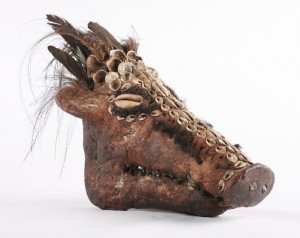
Ceremonial Pig Skull- Latmul Peoples- New Guinea. Childrens’ Museum of Indianapolis
Still, sometimes the proximity of hog and human culture has led to pushback throughout the ages. Anthropologists have surmised that the fact that they had cloven hooves but were not ruminants made them anomalous creatures, banned from Jewish and Islamic tables. More recently, as pork became more popular in the colonial United States, it became increasingly derided. William Byrd II, a Virginian living at the time of the American Revolution, declared that North Carolinians ate so much pork that they began to resemble pigs physically and became, “extremely hoggish in their temper, and many of them seem to grunt rather than speak in their ordinary conversation.” (Mitzelle, 2013).
As close as the hog-human bond can be, some of the best pig stories are those that arrive when hogs are separated from humans. This year, my wife and I celebrated the New Year with friends by roasting a whole hog. The party was a success, and why not? In many cultures eating pig on New Years Day is meant to bring luck (presumably because a family who can sacrifice a pig is already prosperous). But our pig symbolized a wrinkle in pig-human relations.
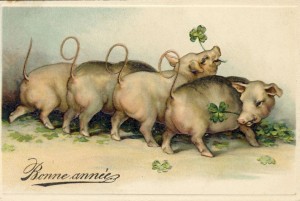
A French New Year’s Eve Postcard (see Michael Garval’s excellent article on French pig postcards here)
Ours was a rare Ossabaw Island Hog, a roaster that enthusiasts claim to be second to none in terms of flavor and purity. That perfection —and it was jaw-droppingly delicious— comes not from human intervention and generations of hybridization, standardization, and homogenization by farmers and Big Pork in search of the perfect pig. Instead the Ossabaws’ goodness owes to the fact that they spent 500 years away from human culture.
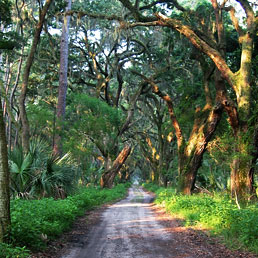
Ossabaw Island’s main road. Photo credit: Laura Drummond.
Pigs arrived on Ossabaw Island, a small barrier reef off the coast of Georgia, with Spanish explorers at the beginning of the sixteenth century. Some were left behind and quickly turned feral. There, they acquired an unprecedented ability to forage off the island’s sparse food offerings and drink water with a high percentage of salt. They also acquired insular dwarfism in order to survive (a full-grown female can weigh as little as 100 pounds) and the ability to store fat prodigiously (no other non-domestic animal is as efficient).
That high fat content and the ability to store fat makes the pigs tastier, but also makes them prone to diabetes and cardiovascular disease. Ironically, that fat also saved them. In the early 2000s, the animals were considered a menace to native populations of sea turtles on the largely undeveloped Ossabaw Island to the point that Georgian conservationist authorities contemplated eradicating them.
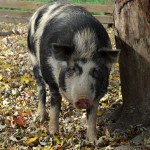
An Ossabaw Pig. Photo credit: livestockconservancy.org
Plans for the pigs changed because 1) Medical authorities sought them out, examining possible gene mutations in Ossabaws in order to understand diabetes and heart disease in humans. 2) High-profile chefs discovered how tasty the meat was, and advertised the merits of Ossabawness (Weiss, 2015).
The fame of the Ossabaws did not save them from being eaten, as was Wilbur’s case. Rather they were saved by being eaten. And saved, somewhat ironically, in the midst of all that good fat, by the shared hog-human susceptibility to heart disease.
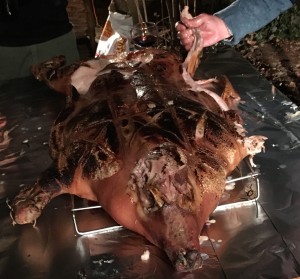
New Years Eve- “Some Pig!”
1) Peter Dwyer and Monica Minnegal, “Person, Place, or Pig: Animal Attachments and Human Transactions in New Guinea,” in Animals in Person: Cultural Perspectives on Human-Animal Intimacies, ed. J. Knight, Oxford and New York, 2005, pp. 37-60.
2) Brett Mizelle, Pig, London, 2001.
3) Brad Weiss, “Hybrids, Breeds, and Brands.” Paper presented at “Pig Out: Hogs and Human in Global and Historical Context,” Yale, 2015.
